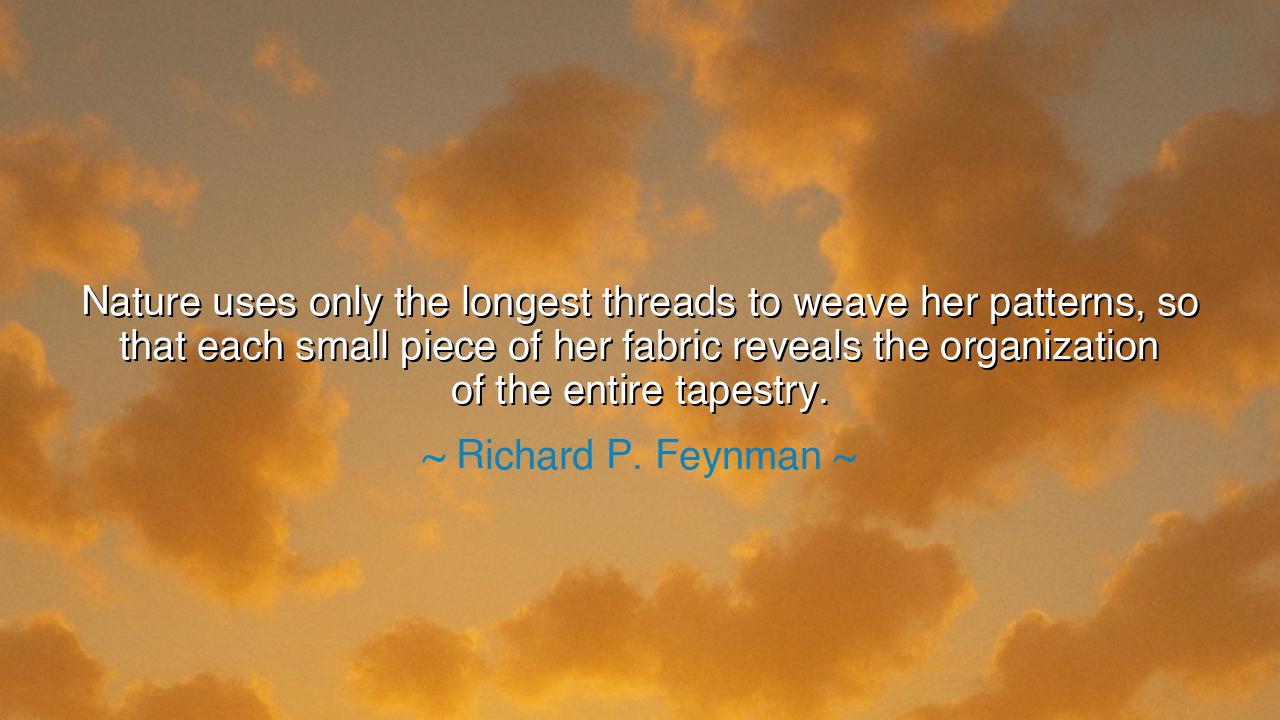
Nature uses only the longest threads to weave her patterns, so
Nature uses only the longest threads to weave her patterns, so that each small piece of her fabric reveals the organization of the entire tapestry.






Richard P. Feynman, the physicist whose joy in discovery was as great as his genius, once said: “Nature uses only the longest threads to weave her patterns, so that each small piece of her fabric reveals the organization of the entire tapestry.” In this sentence lies not only the awe of a scientist but the wisdom of a sage. He speaks of nature not as chaos but as design, a living fabric in which the smallest fragment reflects the grandeur of the whole. A drop of water, a leaf, a grain of sand—within each are hidden the laws that bind galaxies, the threads that stretch across eternity.
The origin of this thought arises from Feynman’s reflections on the unity of physics. For him, the patterns of the universe were not separate riddles but interconnected truths. The same equations that describe the dance of electrons illuminate the stars. The way light bends through a crystal reveals the same principles that shape the cosmos. Nature’s fabric is not stitched with short and broken strands, but with threads that run endlessly, binding the microscopic to the infinite, the local to the universal.
History too testifies to this vision. Consider Isaac Newton, who, watching the apple fall, discerned in that simple act the law of gravity that governs both earth and heaven. Or think of Gregor Mendel, tending his humble peas in a monastery garden, uncovering the laws of inheritance that explain the diversity of life itself. Each worked with the smallest piece of the fabric—a fruit, a flower—and yet revealed the pattern of the greater tapestry. The humble detail, rightly understood, is always a window into the eternal whole.
The meaning of Feynman’s words is deeply emotional and powerful. They remind us that we are never truly cut off from understanding. To hold a seashell is to hold a fragment of the ocean’s history. To observe the spiral of a sunflower is to glimpse the same mathematics that shape galaxies. Even in our own bodies, the structure of our DNA is not isolated chance but a thread woven into the grand fabric of life. Nothing is random or without meaning; everything is connected by threads long enough to cross the universe itself.
Yet there is also a heroic challenge hidden here. If the small contains the great, then we must not treat the details of life as trivial. Every action, every word, every choice is part of the tapestry. To neglect the small is to weaken the whole. Just as a loose thread may unravel a garment, so too does negligence in small things corrode the greater order. But if we honor the detail—if we weave each moment with care—we take part in the eternal artistry of nature herself.
The lesson for us is profound: seek unity, look for the pattern that connects. Do not despair at the vastness of the world, for you can glimpse its truth in the smallest fragment at your feet. Study the detail with reverence, whether it be a stone, a bird, or a thought, for within it lies the whole. And remember that your own life is a thread woven into the greater fabric; what you do matters, for the tapestry would not be complete without you.
Practically, this means living with awareness of connection. When you look upon a flower, do not see only its color, but the sun that nourished it, the soil that cradled it, the rain that kissed it, the bees that drink from it, the universe that shaped it. When you act toward another, see not only the person before you, but the web of lives they touch. In this way, we begin to live not as isolated strands but as weavers of harmony, aligned with the fabric of nature’s tapestry.
Thus, Feynman’s words endure as both revelation and command: the threads of nature are long, and every fragment reveals the whole. Let us then live as seekers of patterns, as guardians of unity, as humble weavers in the eternal loom of creation. For to see the smallest piece is to glimpse the infinite, and to honor it is to live in harmony with the eternal design.






AAdministratorAdministrator
Welcome, honored guests. Please leave a comment, we will respond soon